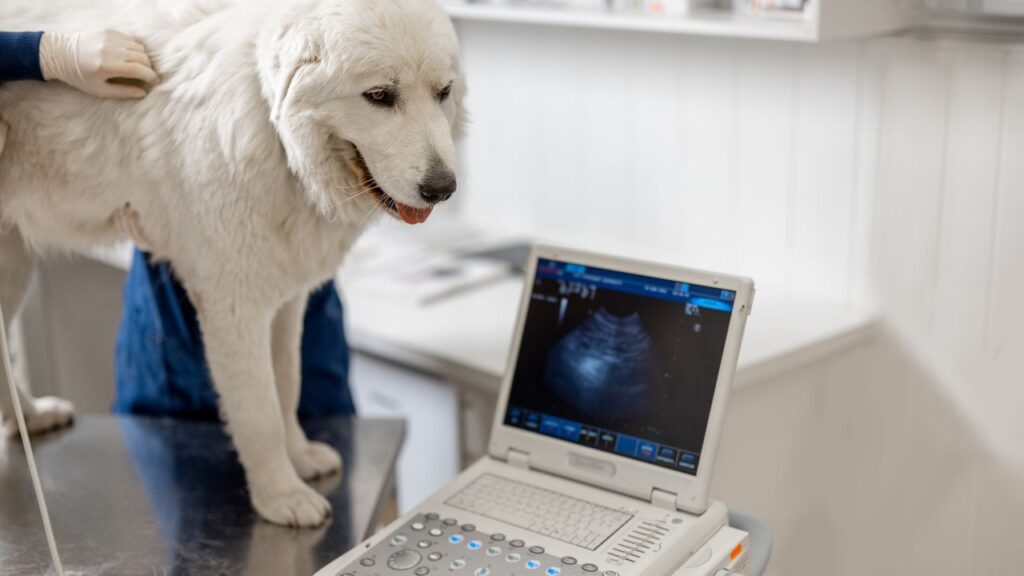A common cancer in humans, prostate cancer in dogs is quite rare. Dogs are often used as a model to study human prostate cancer, which will help new therapies evolve for both people and dogs.
Key Takeaways
- Most dogs with prostate cancer that receive treatment live for about eight months.
- The symptoms of prostate cancer in dogs include straining to urinate, straining to pass stool, blood in the urine, and weight loss.
- Both neutered and unneutered dogs get prostate cancer.
- Dogs can survive without a prostate, but complete removal of the prostate is not generally recommended due to a high risk of complications.
- In the early stages, prostate cancer in dogs is not typically painful. Canine prostate cancer often affects a dog’s ability to urinate or pass stool which can be painful. Prostate cancer can also cause pain in a dog’s back and abdomen.
- Prostate cancer in dogs tends to be aggressive and has a high rate of spread throughout the body.
What is Prostate Cancer in Dogs?
Prostate cancer in dogs is a relatively uncommon condition that makes up less than 1% of all canine cancers.1
The Dog Prostate
The canine prostate is a gland that is part of the male reproductive system. It completely covers the beginning of the urethra, the tube connecting to the bladder to allow urine removal.2
Tumors of the prostate develop from the cells that produce semen fluid.3
Due to the anatomic location of the prostate, dogs with prostate cancer will have changes in urination habits and difficulty having bowel movements.
Prostate cancer in dogs has a high rate of metastasis (spread to other organs), occurring in up to 80% of cases.4
Stats and Facts About Prostate Cancer in Dogs
The most common type of canine prostate cancer is adenocarcinoma, which can metastasize to many sites, including the lungs, bone, lymph nodes, liver, spleen, and colon.4
- It is considered locally aggressive because it can compress or invade other vital structures, such as the urethra or colon (large intestine).
- Canine prostatic adenocarcinoma has a low overall incidence, reported to occur in 0.5% of dogs.2,6,7
- There are two subtypes of prostatic adenocarcinoma: alveolar and acinar.2,8
Other types of cancers that can occur in the prostate include transitional cell carcinoma, fibrosarcoma, leiomyosarcoma, hemangiosarcoma, and lymphoma.5
Canine Prostate Cancer Causes
A specific cause of canine prostate cancer has not been discovered.7 However, it may be associated with androgens (male sex hormones) that are generated in places other than the testicles, such as the adrenal gland.2
Risk Factors for Prostate Cancer in Dogs
Several breeds are more commonly affected by prostate tumors, including:3,6
- Bouvier des Flandres
- Doberman Pinscher
- Shetland Sheepdog
- Scottish Terrier
- Beagle
- Miniature Poodle
- German Shorthaired Pointer
- Airedale Terrier
- Norwegian Elkhound
The most common age that dogs present with prostate tumors is between 10-12 years old.6,9
Neuter Status
Both neutered and unneutered dogs get prostate cancer. The common practice of neutering dogs in the United States makes this a controversial and nuanced topic. Still, neutering dogs at an early age is a risk factor for developing prostate tumors.6
Meanwhile, prostatic adenocarcinomas are more common in unneutered males.6
In some studies, neutered male dogs have been shown to have a higher risk of developing all prostate cancers.10 However, neutered dogs also tend to have a longer lifespan, which is also associated with more cancer development.
In short, we’re not yet completely clear on the role of neutering dogs in prostate cancer, and more research studies are needed. Whether to neuter a dog or not should be carefully considered with your veterinarian.
Veterinary oncologist Dr. David Vail says the most important sign something may be off about a dog is their human's intuitive sense that something isn't right. Trust your gut, and what to look for, on DOG A
Canine Prostate Cancer Symptoms
Similar to human men, in the early stages, dogs may not show any symptoms at all.7
When the prostate starts compressing the urethra, urinary symptoms occur. The most common dog prostate cancer symptoms include:
- straining to urinate
- urinating small frequent amounts
- visible blood in the urine
- constipation and straining to have a bowel movement
- lymph nodes in the sublumbar (under the lower back) region may enlarge
In later stages, dogs may become completely obstructed in the urinary tract and unable to urinate.
In dogs with metastasis, severe weight loss may occur.
If the cancer has spread to the brain or spine, there may be neurologic clinical signs such as ataxia (lack of balance), weakness, or paralysis of the rear limbs.2
If the tumor has metastasized to the lungs, coughing and exercise intolerance may be noticed.
Diagnosing Prostate Cancer in Dogs
In humans, serum screening tests looking at prostate specific antigen is commonly used. This is not as useful as a screening tool in dogs.2,6
The first step to diagnosing dog prostate cancer is a physical exam.
A veterinarian can palpate prostate tumors via digital rectal examination. A firm and irregular prostate will be felt.6
Occasionally, enlarged sublumbar lymph nodes will be found during a physical exam.6
In cases of dogs with partial or complete urinary obstruction, a painful, firm, enlarged bladder will be apparent.6
Imaging Tests
If your veterinarian finds these signs, they will likely want to run more tests, including abdominal imaging.
- On radiographs (x-rays), many cases show an enlarged, mineralized prostate or tissue mass caudal (closer to the tail) to the bladder.6
- The overall sensitivity of using radiography to identify prostatic tumors is 84%.6 Radiographs may also show displacement of the descending colon due to lymph node enlargement.
Ultrasound of the abdomen can give a better impression of the cancer’s effects on surrounding lymph nodes and organs, particularly the liver and spleen.7 An abdominal ultrasound will reveal a prostate that appears enlarged, irregular, and in many cases, mineralized.6
Tumor Samples
Additional tests to aid in diagnosis include cytology or biopsy with histopathology. Cytology can be obtained in several methods including ultrasound-guided fine-needle aspiration, evaluation of prostatic wash fluid, or traumatic catheterization of areas with bladder involvement.6,7
Blood Work
General labwork will also be part of a workup for prostate tumors. A complete blood count may indicate a decreased red blood cell count due to anemia of chronic disease, and there is often an elevation in white blood cells.6
A chemistry profile may be normal or, in some cases, show increased kidney values, particularly if urinary signs are present.
Urinalysis
A urinalysis may show the presence of red and white blood cells. In 36% of affected dogs, secondary infection will also be reported.6 Cancer cells may be seen in the urine sediment of some patients.
Cadet BRAF Urine Test
The Cadet BRAF urine test might also be useful, as it screens for transitional cell carcinoma, one of the cancers that can occur in the prostate. (It won’t tell you anything about any other type of cancer that could be there, however.)
Prognosis and Staging
Staging can get quite expensive, so this is an area where you can weigh the pros and cons.
- The pros of staging are that you and your dog’s veterinary team will have a complete picture of your dog’s health and what parts of his body are affected by the cancer. This information can give you a more accurate idea of how he might do and might also rule in or out some treatment options.
- The cons are that it is expensive and does not always give information that will change your decision. If you have limited funds, allocating your money for treatment may be the better choice.
Grading of canine prostatic tumors is not routinely performed as it is in people. All canine prostatic carcinoma subtypes are considered malignant with a high metastatic potential.6
Staging relies on chest radiography, abdominal ultrasonography, and imaging of any regions that are concerning for metastasis, particularly lymph nodes, lungs, liver, spleen, and bone.6
Spine and chest radiographs should also be investigated to look for distant metastasis since most dogs are diagnosed at advanced stages.11 Metastasis to the lungs is found on chest radiographs in 44% of dogs at the time of diagnosis.6
Other tests less commonly pursued include nuclear scintigraphy or computed tomography (CT) to look for skeletal metastasis.
Magnetic resonance imaging (MRI) of the brain and spinal cord may be useful for dogs with neurologic signs.6
Occasionally, immunohistochemistry is recommended if the biopsy requires additional testing to differentiate between adenocarcinoma and other carcinoma subtypes, such as transitional cell carcinoma.6
Renée Michael knew something was wrong with Roscoe, and followed her gut to get him as much time as possible. Now she advocates for all dogs with prostate cancer. Hear the amazing True Tail on DOG CANCER ANSWERS.
Dog Prostate Cancer Treatment
Cancer treatment in dogs is not usually about getting a “cure.” Instead, the focus is on improving and maintaining quality of life while hopefully extending the dog’s life beyond what would happen if the cancer wasn’t treated.
Several new therapies are being evaluated to treat canine prostate cancer.
NSAIDs
Oral non-steroidal anti-inflammatory drugs (NSAIDs) are an important component of treatment for prostatic carcinomas.6 NSAIDs have been shown to improve survival times and may improve quality of life in dogs with prostatic carcinoma.
The commonly used NSAIDs are piroxicam and carprofen, which, in addition to anti-inflammatory effects, may also have an antitumor effect.6
The median survival time of dogs treated with NSAIDs alone was about seven months, versus a one-month survival time with no treatment.6
Side effects of NSAIDs include gastrointestinal ulceration and kidney and liver damage, particularly over the long term.
Antibiotics
Many dogs have secondary bacterial prostatitis, or inflammation of the prostate.6 Antibiotics that penetrate the prostate should be selected based on culture and susceptibility testing results. Common antibiotics that penetrate the prostate include fluoroquinolones, chloramphenicol, and trimethoprim-sulfamethoxazole.6
Bisphosphonates
Therapy with bisphosphonates may be indicated if there is metastasis to bone. Bisphosphonates such as pamidronate may relieve pain and reduce the risk of pathologic fracture due to bone metastasis.6
Palladia
In recent studies, toceranib phosphate (Palladia®) has been suggested to affect genes involved in the progression of canine prostate carcinoma.4
Surgery
Surgery is not usually curative for prostate tumors because complete excision of the tumor or removal of the prostate is usually impossible due to location and invasiveness. Also, after surgery, the disease generally recurs and still metastasizes.
Your veterinarian may still recommend surgery, however, in some cases.
Urethral Obstruction
The primary concern of surgery is to address urethral obstruction that may cause bladder rupture.6 If the bladder has already ruptured, surgery is a medical emergency.
Prostate Removal
Complete prostatectomy (prostate removal) is not often used to treat canine prostatic cancer due to the high risk of complications. It is considered in early-stage disease, however.
Risks include urinary incontinence, infection, and necrosis (death of cells of an organ) of the colon. The median survival time post-complete prostatectomy is 17 days. Typically, the cause of death is surgical complications or tumor progression, or the dog lover choosing to euthanize their dog humanely for those reasons.6
Intracapsular Prostatectomy
A subtotal intracapsular prostatectomy is another surgical option associated with a lower rate of postoperative complications than a complete prostatectomy.6
This surgery only removes part of the prostate and immediately improves clinical signs. The median survival time for dogs following subtotal intracapsular prostatectomy is 130 days.6
Other Surgeries
Other prostate surgical procedures include laser ablation, photodynamic therapy, and transurethral resection.6
Some procedures may be pursued to provide improvement of clinical signs without treating the tumor specifically, including urethral stent, placement of an indwelling urethral catheter, cystostomy (opening into the bladder) tube, and prostatic artery embolization.6
Chemotherapy
Chemotherapy has not been well studied for the treatment of canine prostatic carcinoma. It may be considered in cases with metastasis.
Some protocols include carboplatin or mitoxantrone in combination with an NSAID.9,12
The potential adverse effects include bone marrow suppression, nausea, vomiting, and diarrhea.
Radiation
Radiation therapy is frequently used for canine prostatic carcinoma. There aren’t many studies on it, but your oncologist may recommend it.
One study showed that the median survival time for dogs with localized prostatic carcinoma with no metastatic evidence was 180 days with radiation therapy. Dogs who had surgery and intraoperative radiation had a survival time of 114 days.13
Radiation has some risks, of course. Specifically to prostate cancer, it can cause complications such as chronic colitis (inflammation of the colon) and urethral stricture, which restricts urine flow from the bladder.6
Overall radiation therapy seems to be tolerated well but needs further evaluation.
Immunotherapy
Immunotherapy in combination with multi-agent chemotherapy and hormone therapy is being studied for the use of canine prostatic carcinoma.9
This type of therapy led to a six-to-nine-month survival in dogs without metastasis or ones that had only spread to lymph nodes.
Antibody drugs have been studied recently and show promise for canine patients.14 These treatments are not currently available for veterinary use, but your oncologist will be able to update you on their progress.
Vaccine
Spuleucel-T is a vaccine approved for human prostate cancer and is approved by the Food and Drug Administration (FDA).15 The vaccine has shown benefit and works by stimulating the patient’s immune system to attack the cancer cells. In human prostate cancer, several other therapeutic vaccines have entered clinical trials.16
This is not yet approved for dogs, but your oncologist will have that information if it becomes available for use.
Supplements
Dietary supplementation with selenium has been shown to decrease DNA damage in the aging canine prostate and may decrease the incidence of canine prostatic carcinoma.17
In one study on unneutered male beagle dogs, the dogs receiving selenium supplementation had about 20% less DNA damage than the control group.
Selenium is also suggested to increase cell death of aging or damaged cells. The specific mechanism by which selenium supplementation exerts its anticancer effect on the prostate is unknown.17
End Stages of Prostate Cancer
The end-stage disease of canine prostatic carcinoma is associated with abnormal urination, weight loss, and often signs associated with the cancer’s metastasis.
Signs of general decline, including lethargy, decreased appetite, and changes in demeanor, may also be seen.
Signs associated with metastasis may include:
- Bone metastasis can be very painful and may cause a decline in the quality of life in canine patients with metastatic prostatic carcinoma.
- Those with pelvis or lower spine metastasis may also have neurologic deficits.
- Decreased energy levels, exercise intolerance, and coughing are associated with lung metastasis.
Prevention Strategies
Currently, there are no known strategies to prevent this rare cancer definitively.
Some human studies show a significantly reduced prostate cancer risk in men with adequate selenium levels.17,18
It’s certain that regular physical exams, including digital rectal examination in older dogs, may help identify prostate abnormalities earlier. If your male dog is over the age of six, it is a good idea to ask your veterinarian (nicely) not to skip a digital rectal exam during a wellness visit.
Was Remyʻs late-in-life neuter responsible for his recent prostate cancer diagnosis? Also, can dietary changes and supplementation help? Dr. Demian Dressler answers on DOG CANCER ANSWERS.
Topics
Did You Find This Helpful? Share It with Your Pack!
Use the buttons to share what you learned on social media, download a PDF, print this out, or email it to your veterinarian.









